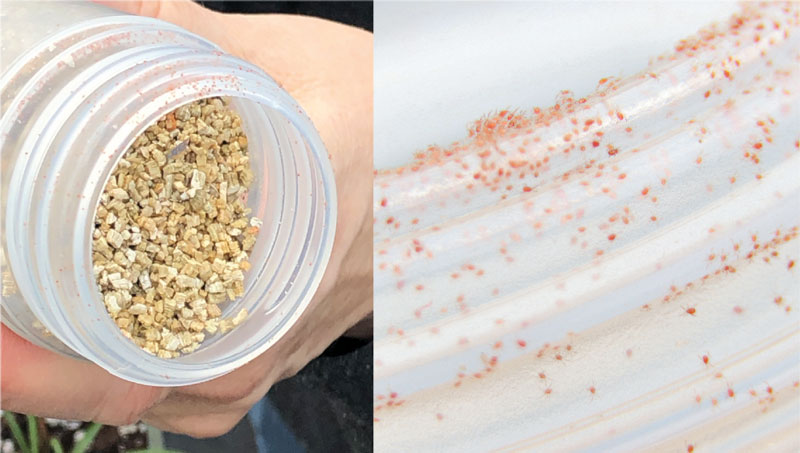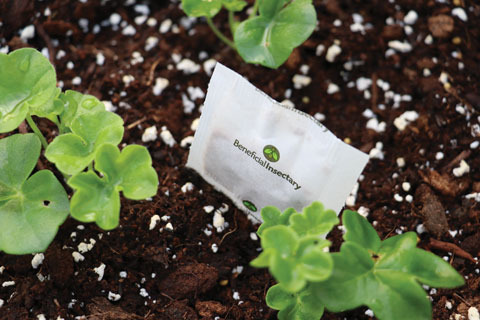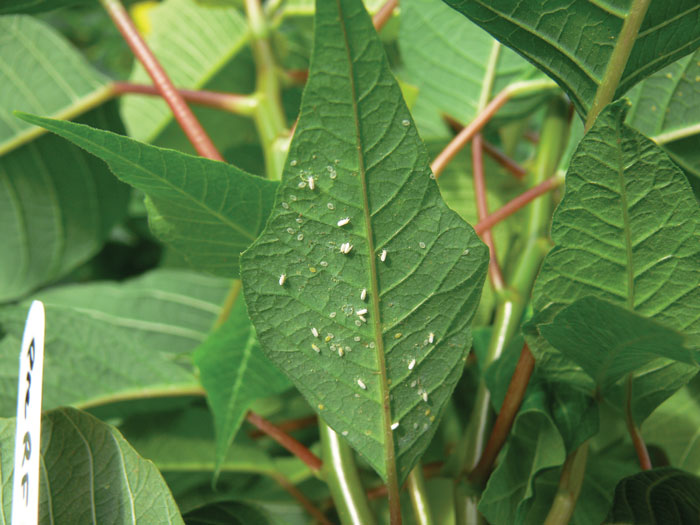2/1/2020
Is “Zero Tolerance” Realistic?
Ronald Valentin
The question about clean plant material, whether it’s unrooted, rooted cuttings or young plants, is still very much a discussion point in our industry. It’s a very important part to think about, as what happens with crop protection during the propagation stage often determines the success of your pest management strategy during the rest of the crop cycle.
The term “zero tolerance” is still sometimes used in these discussions, but how realistic is this expectation of having absolutely zero pest (or disease) on young plant material coming into the doors of the greenhouse?
There’s been a shift in thinking zero tolerance and eradication strategies (which failed) to management strategies to produce “clean” young plant materials. Awareness, communication and transparency of pest management strategies during this critical part of production is a welcome tool for all involved. It will take out the guesswork and will benefit any pest management strategy. However, especially for growers using biological control agents (BCAs) as a first line of defense in their strategy, it can be the difference between success or failure, as some pesticide residues can have a residual effect on BCAs being applied after propagation stage.
For growers who’re still using traditional crop protection products as their strategy, this information can be a welcome tool to make sure that they can rotate products with a different classification and mode of action to reduce the chance of resistance development and maximize efficacy of the products they use.
“Clean plants”: Learning the greenhouse vegetable industry
The greenhouse vegetable industry has gone through this same situation, but at least three decades ago. Growing up in the greenhouse vegetable industry in the Netherlands, my parents owned and operated a 6-acre hydroponic tomato production greenhouse. When my father took over from my grandfather in 1966, the meaning of a “clean” plant was very different from what it is today. Clean plants were plants that had NO bugs (what’s still called zero tolerance today).
My father implemented biological control for the first time in 1971 to control whitefly in his tomato crop. The reason for this switch was the pesticide resistance that hit the vegetable industry at the time. In those early years, implementing biocontrol in vegetables wasn’t always easy and it was often hard to find reasons why things didn’t work out as they were supposed to. But by trial and error, the keys to success were found. A few keys to mention are commitment, start early in the crop cycle, monitoring, management from beginning to end of the crop and not to forget patience.
 Pictured: Predatory mite of two-spotted spider mites Phytoseiulus persimilis being released.
Pictured: Predatory mite of two-spotted spider mites Phytoseiulus persimilis being released.
One concern out of this list was an early start of releasing BCAs, in this case Encarsia formosa for whitefly, early in the crop. This was done on a preventive basis, even if whitefly wasn’t seen yet (doesn’t mean that they weren’t present). Greenhouse vegetable growers in the Netherlands were getting their young plants started by specialized propagators and plants would arrive at the greenhouse at about six weeks of age.
Of course, these plants needed to be clean. However, it became evident quickly that clean wasn’t always “clean.” Plants would come in still with pests present, but not only that—the plants also had been sprayed with many pesticides that aren’t compatible and have residual effects of BCAs, some of them long residual effects.
In those years products such as oxamyl (Vydate), methomyl (Lannate), endosulfan (Thiodan) and acephate (Orthene) were still registered for use in vegetable crops in the Netherlands. This was, in many cases, a difficult start of a biological pest management program. Within years, an understanding between the propagators and their customers developed about pest management and what a clean young plant would or should be.
The words “zero tolerance” disappeared, as it became clear that low levels of pest and NO long residual pesticides was a better option than still low levels of pests AND long residual pesticides, which basically meant that the grower has a hard time getting his biological pest management program started. It was basically determined that zero tolerance is extremely hard, if not impossible, to achieve and that using an arsenal of pesticides doesn’t guarantee a plant clean of pests!
Today, most vegetable propagators are working with an IPM program, which is using BCAs as a first line of defense. That doesn’t mean that they never use a pesticide, but if they do, it’s a BCA compatible, or at worse, a pesticide that doesn’t have a long negative residual effect. With this technique, they’re not only leaving the customer (grower) with plants on which BCAs will start successfully, but also do their part of pesticide resistance management, as they use very little pesticides.
What does this mean for the ornamental industry?
As many of us know, pesticide resistance has been experienced in the ornamental industry, especially with thrips, two-spotted spider mite and whitefly. This is not only in our country, but on a global basis. With the global trade of plant material, if pesticide resistance shows up somewhere, within a very short time it’s transported around the world.
This pesticide resistance has been a motivator for ornamental greenhouse growers to look at alternatives for pest management, just like their vegetable grower colleagues did in the ’70s and ’80s. The use of biological control is increasing in the ornamental industry on a worldwide basis, too. There are many growers who are really very successful, but just like the vegetable growers had to go through a learning curve, so did the ornamental greenhouse industry over the last 10 years, and probably several years to come. There is, however, one similar issue in the ornamental industry that the vegetable growers faced more than 30 years ago: “CLEAN” propagation material, cuttings, rooted or unrooted.
An example of pests coming in
Recent studies done in Canada have shown that thrips, two-spotted spider mite and whitefly are expected to be present on incoming plant material/
cuttings. It started 10 years ago (2010) at the University in Guelph in Ontario when five main varieties of potted chrysanthemums were checked for the presence of thrips that hitchhiked on incoming cuttings.
 Pictured: Newer biocontrol delivery methods, such as breeding sachets on a stick, have proven to be successful.
Pictured: Newer biocontrol delivery methods, such as breeding sachets on a stick, have proven to be successful.
For eight months and every two weeks samples were taken. Not one single sample came in as clean, and in all samples, adults and immature thrips were found. In some samples, two adult thrips for every cutting were present. This is obviously a challenging start, but what’s even more concerning is the arsenal of pesticides that were applied in these stock plants. This means it’s very likely that these thrips are highly resistant to many pesticides.
The growers involved in this project work with BCAs as part of their pest management and poor results were the motivation for this initial work in 2010.
An example of pesticide residues
In the Netherlands, a three-year project to address this issue of clean cuttings started in 2010. In this project, the objective was to determine pesticide residues on cuttings of different crops coming in from different parts of the world. The motivation behind this project was that these residues are a suspect of why BCAs have trouble getting to work after arrival at the growers’ greenhouses.
During the project, 39 samples were taken in the potted plant sector. In these 39 samples, they found 302 pesticide residues; of these, 115 were compatible products, 55 needed to be considered individually, as they were compatible with some BCAs and not with others, and a total of 132 were not compatible products.
The results of this project were considered in more strict regulations set by the EU on pesticides that no longer have a registration within the EU and its members. This effectively took many of the older long-residual pesticides out of the toolbox for young plant/cutting production outside the EU, which then produced cleaner cuttings.
Where is the ornamental industry with “clean” cuttings and plugs?
Many breeders and propagators (rooting stations) have already implemented pest management strategies that are no longer focused on zero tolerance, but on producing clean cuttings. Newer tools in the toolbox, such as development in new BCA delivery methods (breeding sachets on a stick), the addition of biopesticides and application (dipping), and a few compatible pesticides have been successful. It not only benefits growers that are working with BCAs in their pest management program, but also growers who are working with traditional pesticides and aren’t ready yet to implement BCAs.
 Pictured: Whiteflies on a poinsettia leaf.
Pictured: Whiteflies on a poinsettia leaf.
The goal is to have propagative material coming out of a pest management program that excludes long residual pesticides and leaves the option open for the grower to implement BCAs or a traditional pesticide program after they receive their young plants. Propagative material that includes a whole arsenal of pesticides AND still has pesticide-resistant pests makes it more difficult for the grower to make any pest management program work.
Starting clean and minimizing risk
Of course, it remains important to inspect any incoming propagative materials for the presence of pests and diseases, but it’s unrealistic to think and expect that there’s zero tolerance. It’s more challenging to see what type of residues are present without doing residue testing. Transparency of information on what pest management tools and products were used during the propagation will benefit growers and help them to make better decisions on their own pest management strategy. This would also help growers using traditional pest management strategies to choose their pesticides wisely.
What’s still important is to determine what’s acceptable and not acceptable as far as pest levels go. For example, unrooted poinsettia cuttings will most likely have some whitefly, but when every cutting has as many as five to 10 adult whiteflies at the point of arrival, then there’s obviously a problem.
To reduce the level and risk of pests coming in through the door, many growers have started to treat rooted and/or unrooted cuttings with products such as BotaniGard WP (Beauveria bassiana), biological fungicides such as RootShield and RootShield PLUS (Trichoderma harzianum T-22/virens G-41), and NemaShield (nematode Steinernema feltiea). Treating and dipping cuttings before they enter the greenhouse doesn’t eliminate pests, but significantly reduces the number and risks.
For example, the study at the University of Guelph has shown excellent results on adult and immature thrips, but it does very little on the eggs of thrips, as they’re protected in the plant tissue. By affecting adult and immature thrips, it will lower the total number and buys the grower (and the BCAs) some time if pesticide residues are suspected. NemaShield (nematodes) and BotaniGard WP (entomopathogenic fungi) work on contact, so dipping is the best way of getting optimal coverage. Applying the products mentioned above as a spray after sticking or planting will have an effect, but dipping beforehand makes an escape of getting in contact with the solution very difficult. It’s therefore the first line of defense for incoming young plant material.
The above treatments have no residual effect on BCAs, but aren’t exclusive to ONLY growers that are using BCAs as part of their pest management program. It certainly can be used by any grower, regardless of their choice of pest management program to have a cleaner start. GT
Ronald Valentin is Technical Director BCA for BioWorks, Inc. and has been active in Biological Control for over 30 years in Europe, Canada and the U.S. He can be reached at RValentin@BioworksInc.com.